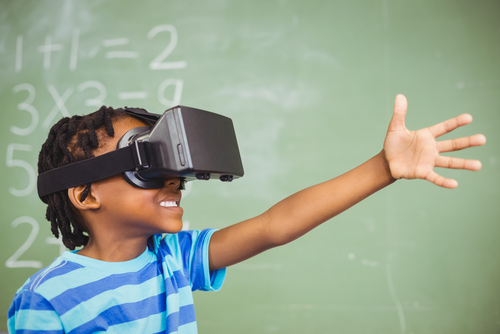VR and AR offer capacities that resonate with pupils with special needs. Augmented reality (AR) and Virtual reality (VR) have recently helped teachers educate, inspire, and improve classroom interaction for students of all classes and abilities by making learning more accessible, practical, memorable, and engaging.
VR takes the user in a 3D environment where they hear, touch, smell, and taste stimuli. Students interact via a conventional desktop computer and VR software or wear a head-mounted display (HMD) and data glove. AR improves physical content with 3D effects so that consumers remain outer observers and recognize the augmented effects through apps like Google Lens.
What is XR?
Augmented, Virtual, & Mixed realities are illustrations that all fit in the bucket of tech jointly known as extended reality (XR), an umbrella name used to refer to virtual reality (VR), augmented reality (AR), and mixed reality (MR). VR is a wholly immersive experience that eliminates the physical world from view; AR is a technology where virtual images are overlaid on our physical world; MR is a newer type of technology where an altered reality lets users interact with virtual objects real-world environment.
The challenges implementing VR and AR are largely logistical and technical. Qualified staff and a lot of space are necessary for VR, and users can get easily distracted and have to be trained in electronic competencies. Apps entail data protection and privacy problems. Equipment may also be expensive.
However, schools can use limited AR and VR solutions, especially to encourage students with special learning needs.
The Benefits Of Virtual Reality For Students With Disabilities
By creating environments that simulate an individual’s physical presence in worlds actual or imagined, VR can help students with disabilities develop their knowledge, skills, and attitudes in ways that would not have been possible otherwise, allowing them to take part in learning tasks relatively free from the constraints imposed by their disability, and in total protection. VR also helps create empathy for individuals with disabilities in others by supporting them to experience disabilities via simulated environments. Below are a few of the more obvious benefits.
Overcoming Physical Limitations
For learners with physical impediments that limit their motion, VR can access previously unattainable learning experiences. By providing them the ability to navigate a virtual world at will, VR can help them experience things they might have just ever imagined otherwise without restraints. For example, an individual using a wheelchair could learn about surfing standing up.
Creating Safe Spaces
Virtual reality could help learners with communication challenges such as autism or Asperger’s to develop and practice social skills in non-threatening surroundings, such as offering access to learning opportunities from the safety and comfort of their own homes. Conversely, it may also help people experience the world from the view of those learners.

Supplying Protected Experiences
For people learning how to handle new sensory or physical disabilities, difficult or risky learning experiences can be accomplished safely through VR. First-time wheelchair users, for instance, may use VR to understand how to navigate a busy road or shopping center in a digital environment, safely knowing how to move around and avoid obstacles in that digital setting before entering the real world.
Personalized Learning
For students with diverse special needs and learning styles arising from other disabilities, VR can help accommodate learning experiences. By way of instance, VR is a powerful tool for helping autistic kids learn social interaction and nonverbal cues in individualized environments. Virtual environments or input stimuli are manageable to match exactly what is tolerable to the student.
Eliminating Distractions
VR can provide a distraction-free experience for students with attention deficiency challenges since the virtual reality headset entirely covers their perspective. The immersive environment of a VR experience can encourage sustained attention and focus. Further, VR could provide individuals with ADHD that high levels of stimulation and immediate, realistic answers to behavior in the virtual world that would make them feel less anxious and more comfortable.
Given all the above benefits, it is heartening to note that VR in training and learning is rapidly becoming popular, with new tools being developed.
Supporting Pupils with Special Needs
Both VR and AR have been shown to increase motivation, ease interaction, develop cognitive skills, enhance short-term memory, and make lessons more enjoyable. The best effect lies in improving communication skills, particularly in students with hearing issues. For autistic pupils, VR appears to facilitate social interaction.
Examples of AR and VR used to help students with disabilities crowd. Teacher Veronica Lewis makes use of Google Chromecast to enlarge pictures for visually impaired people. She uses VR screen readers, such as VoiceOver and TalkBack, that explain the environment with information from text from the videos and images.
Morehead State University expert Sue Parton has shown how deaf pupils gain from Google Glass and 2D barcode camera phone scanning and video. At The Deaf and Dumb School, Gujarat, India, where some pupils do not recognize their names, the staff uses VR images processed via Foton’s program to teach them. Various studies have demonstrated that VR and AR help users on the autism spectrum understand facial emotions and develop their social skills.
For learning disabled individuals, AR can improve language through gamification. In India, teachers have created an interactive textbook that uses 3D images, audio clips, and videos to describe the text. Other studies reveal how VR has been efficiently utilized to improve social stress, language deficiencies, attention deficit hyperactivity disorder (ADHD), motor or physical disability, dyslexia, cognitive deficits, and Down syndrome, among other disabilities.
At the 53rd St. School in Milwaukee, a special needs teacher, Megan Rierdon, uses Google Earth VR for field trips. “The kids sat in a chair, place on a virtual reality headpiece, and watched a tour walking around a whole greenhouse,” Rierdon stated in the Milwaukee Journal Sentinel. “They were reaching down to reach the dirt and waving to the people they saw.”
AI-based coaching with Molly Porter helps equip students to explore their disabilities with interviewers.
Too much sensory overload? At the Perkins School of the Blind comforting 360-degree videos of animate or inanimate objects or places is used to calm pupils.

VR Learning Resources
The availability of VR apps is developing dramatically, and with each new bit of software, another route is opening up for students. Here are a couple of examples.
Google Expeditions is a VR teaching tool that enables students to take virtual trips on the Mars surface, through a museum, or even across Antarctica. There are near about 500 expeditions.
Knowledge and skills obtained by disabled people in simulated environments can move to the real world.
Platforms like Embrace the life VR help wheelchair users learn to navigate various environments successfully while offering a positive therapeutic effect that reduces anxiety, improves social integration, and enhances life quality.
Titans of Space offers a tour of this Solar system, great for a few science courses.
It’s important that learners with disabilities also take advantage of all these resources, but virtual adventures need to be designed with access in mind to succeed.
VR Accessibility
VR can improve the learning, and even the quality of life, of individuals with disabilities. However, for them to use VR efficiently, the hardware and software technologies will need to be accessible and compatible with assistive technology used by some people with disabilities. Recent technology poses some problems:
- Precise tracking and complete recreation of our body movements make VR challenging for those who have physical disabilities.
- Depending mainly on visual cues leaves individuals with visual impairments behind.
- The high price of popular VR headphones makes them difficult to acquire.
But, there are alternatives available, too:
- Spatial audio cues may be used for navigating and interacting with virtual surroundings. Google’s Daydream labs have some experiments going on here.
- Low-range VR headsets, like the Google Cardboard, which works with cellular phones, are bringing VR within shared reach.
- Walk-in VR Driver is a software application that makes VR Games and Apps more accessible for everybody. It makes the following promises:
- People in a wheelchair can prone, stand, kneel, and turn around 360 degrees in VR without needing to carry out the actual world movement.
- People who have one arm can play a digital control in the VR space.
- Those who can’t use their hands for motion and button pressing can utilize a third-party Xbox controller to carry out those functions.
- Those who cannot move their controls to the height or thickness required by the video game can correct the controls’ position and movement range.
- Those who need more working space can adjust their VR control’s motion sensitivity derived from their physical control.
- Those that have a limited selection of movement in their wrists can alter the idle orientation of the control in VR.
- Google’s Daydream VR controller has been designed with accessibility in mind from the start.
Hence, there is developing potential for accessible VR to make great learning experiences for students with disabilities.
More Promising VR and AR Options on the Horizon

Image credit: igym.solutions
With advancements in VR and AR on the rise, applications are immense. By way of instance, a group of investigators at the University of Michigan are developing iGYM, an AR system designed to educate wheelchair-bound children’s community-level sports.
Developers are also starting to prioritize accessibility during the design, resulting in lighter headsets and much more user-friendly controls, among other gear, for users with physical handicap; appropriate color selection, audio descriptions, and text and image magnification for kids that are blind; and apparent transcripts and closed captioning for consumers that areVR And AR may help disabled people deaf or hard of hearing.
From students to professionals, virtual reality is fast finding its place in learning. It might be the tool that levels the playing field when making learning experiences available to individuals with disabilities. Existing and emerging VR technology must be made available to a variety of users. Having people with disabilities to test or, better still, help create the VR experience during multiple phases of development would guarantee this.
Finally, teachers will use augmented and virtual reality to produce a classroom environment that suits any student’s needs.







